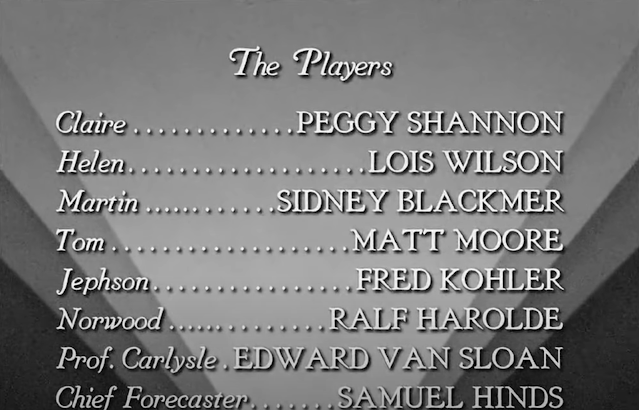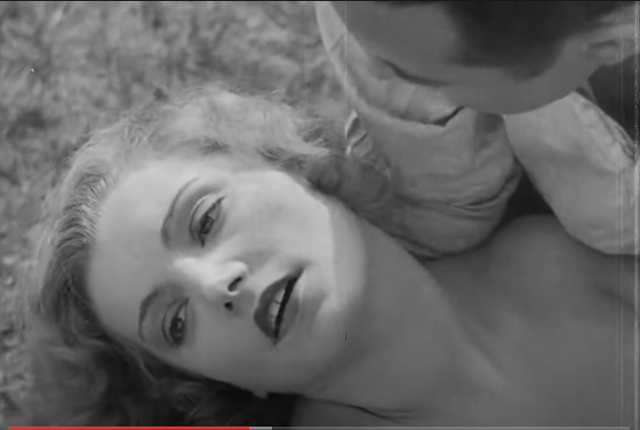Usually the films I examine in the "Movies with Alabama Connections" series are fictional, but this one is a "documentary" short made during World War II. I ran across it recently and thought it featured several interesting elements. The film was released in 1942 by the Agricultural Adjustment Agency, U.S. Department of Agriculture. Created during the New Deal, the agency promoted modern agricultural methods and agriculture's importance to the nation. Henry Browne, Farmer was nominated for a Documentary Academy Award in 1943.
In its nearly eleven minute running time, the film has three parts. The first is a brief opening that sets the context of agriculture's importance to the nation's effort in World War II. We see marching soldiers, tanks, a scene in a factory. Then the narrator tells us agricultural production is just as vital. The second, main section depicts a day in the lives of Henry Browne and his family on the farm. Finally, we see the family make a special visit to Tuskegee.
Below are some screen shots and further comments. This film, along with three earlier ones from the Agriculture Department dealing with African-Americans, are given extensive analysis in J. Emmett Winn's 2012 book, Documenting Racism: African Americans in US Department of Agriculture Documentaries, 1921-42 [Continuum, 2012]. You can find the detailed chapter on Henry Browne, Farmer and the rest of the book here.
Winn notes, "As with the other films addressed in
this book, the filmmakers constructed a reality that informs and persuades the
audience to understand and accept the content as accurate and believable. Henry
Browne accomplishes these goals by showing the Brownes as they go
about their lives on the farm; segments include the introduction of the members
of the Browne family and their farm, the family eating a nutritious breakfast,
the merits of the family garden, the importance of raising livestock, the
preventive maintenance and reusing of materials, and the careful use of the
land. Each of these segments demonstrates that the Brownes are model farmers
who utilize the best judgment and practices in managing their farm and home." He also observes that unlike the other agency films about African-Americans, the race of the Brownes is never mentioned.
Despite the realism, the family is apparently fictional. No one is named except the father and his son Henry Jr. The individuals playing the father, mother, children and older brother may have been Macon County residents, but are not credited in the film. I presume the Agricultural Adjustment Agency would not have had the budget to bring in actors from elsewhere. I did not find a Henry Browne and family in the 1930 or 1940 U.S. Census for Macon County.
In the final pages of his chapter, Winn addresses the ultimate irony of Henry Browne, Farmer. "The Brownes live in a black America
that is separate from white America, and the film suggests that the situation
is not just okay; it is good. I argue that the film is deceptive in its support
of the doctrine of separate-but-equal Jim Crow racism. The Brownes thrive in a
racially separate world where everything is not only going well but also
improving. In the last year the Brownes have improved their meals, livestock,
and crops. In comparison with the other USDA films about rural black
populations, Henry Browne presents favorable conditions for
African American farmers in Alabama." The Browne family seems to exist in its own successful world outside the realities of segregation and the real status of blacks in America at the time.
The film was a success in that it was shown to many black audiences around the country by extension agents and distributed to some 500 theaters by Republic Pictures. Walter White, who was Executive Secretary of the NAACP for many years, wrote to the Agriculture Department praising the work. You can watch the film at the U.S. Library of Congress' web site.
Three men are credited on the film. Roger Barlow [1912-1990] has various director and cinematographer credits listed on the IMDB between 1937 and 1973. Gene Forrell [1915-2005] was a composer and conductor with various credits--mostly documentary shorts--on the IMDB between 1942-1965. His Wikipedia entry has a bit more information.
After working as a jockey, boxer and musician, Canada Lee [1907-1952] became an actor in the Federal Theatre Project and worked in Orson Welles' 1936 production of Macbeth featuring an all-black cast. Before World War II Lee was also active in civil rights causes. After the war he was blacklisted and died just before he was to testify before the House Un-American Activities Committee.
After the scenes of marching soldiers, tanks on the move and industrial factory production, the camera moves to a rural scene and pans from the Browne's barn to the house.
We see farmer Browne washing his face first thing in the morning.
The younger son is shown milking a cow.
After their initial household and barn chores are done, the husband, wife, and two younger children sit down to a hearty breakfast.
Then Henry Browne heads to one of his fields to begin plowing after checking soil conditions.
Before she and her mother head to the garden to weed, the younger daughter goes to the hen house to collect some eggs.
These stills have an artistic feel, foregrounding the iron pot and ax with the hen house/barn in the background and the bucket and tools hanging on a wall.
Mother, son and daughter hoe the garden; Henry Browne can be seen at the plow in the background. This scene shows the family working together as a team to make their land as productive as possible.
Here the family climbs into their wagon for the trip to Tuskegee. No rest for the mules!
In the background we can see the marquee of the Macon Theater which opened in 1935. The facility featured two auditoriums, one for whites and one for blacks. Of course, restrooms, drinking fountains, ticket offices, entrances and concessions were also duplicated.
Their son is at the gate to meet his family, and they walk toward the airfield.
Here the son is being helped into his parachute before his practice run as a pilot.
The rest of the family watches proudly as his and other planes take off.
Washington [DC] Star 18 Nov 1942
Michigan Chronicle 12 Dec 1942
Northwest Enterprise [Seattle] 30 December 1942
































































